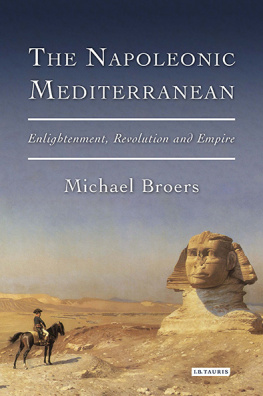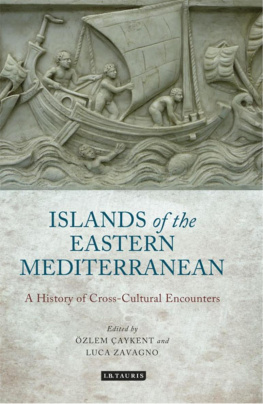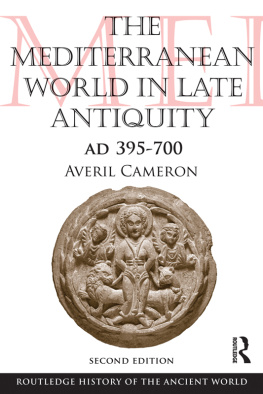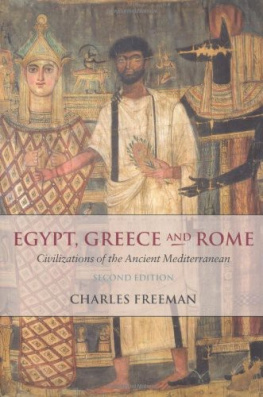THE MEDITERRANEAN WORLD
The Mediterranean World
From the Fall of Rome to the Rise of Napoleon
MONIQUE OCONNELL & ERIC R DURSTELER

This book was brought to publication with the generous support of the Gladys Krieble Delmas Foundation.
2016 Johns Hopkins University Press
All rights reserved. Published 2016
Printed in the United States of America on acid-free paper
9 8 7 6 5 4 3 2 1
Johns Hopkins University Press
2715 North Charles Street
Baltimore, Maryland 21218-4363
www.press.jhu.edu
Library of Congress Cataloging-in-Publication Data
OConnell, Monique, 1974 author.
The Mediterranean world : from the fall of Rome to the rise of Napoleon / Monique OConnell, Eric R Dursteler.
pages cm
Includes bibliographical references and index.
ISBN 978-1-4214-1901-5 (pbk. : alk. paper) ISBN 978-1-4214-1902-2 (electronic) ISBN 1-4214-1901-7 (pbk. : alk. paper) ISBN 1-4214-1902-5 (electronic) 1. Mediterranean RegionHistory4761517. 2. Mediterranean RegionHistory15171789. 3. Mediterranean RegionHistory17891815. I. Dursteler, Eric, author. II. Title.
DE 94.O27 2016
909'.09822dc23
2015018706
A catalog record for this book is available from the British Library.
Special discounts are available for bulk purchases of this book. For more information, please contact Special Sales at 410-516-6936 or .
Johns Hopkins University Press uses environmentally friendly book materials, including recycled text paper that is composed of at least 30 percent post-consumer waste, whenever possible.
CONTENTS
MAPS
PREFACE
O ne of the great benefits of Mediterranean history as a field is that it allows us to step outside of traditional frameworks of nation-state and civilizational conflict and to offer alternative perspectives on how Europe, Asia, and Africa interacted in the premodern world. This process of challenging preexisting assumptions about the shape of the past can transform how we see ourselves and the world around us.
Any attempt to cover 1,300 years of history in 300 pages leaves out more than it includes, and experts on the various regions included here will be discomfited by the superficial treatment of many topics and themes essential to more specialized considerations. In fact, almost every paragraph of this book could be expanded into its own chapter. In our view, the benefit of such a general survey will be to hook a new generation of students and to engage enthusiasts of Mediterranean history, spurring their curiosity toward further investigation. Since this book is aimed at a more general readership, we have dispensed with footnotes and offer instead brief reading lists for each chapter that indicate our main scholarly debts and provide suggestions for further exploration.
We are deeply indebted to the Gladys Krieble Delmas Foundation for providing significant support for the research, writing, and publication of this volume. We both began our careers as students of Venetian history and benefited from the Delmas Foundations generosity then, and we are profoundly grateful that the trustees and advisory board, especially George LaBalme, were willing to follow us on our journey out of the lagoon and into the larger cross-currents of the Mediterranean world. Indeed, Venice can be seen as a microcosm of the problems and themes of Mediterranean history in several ways. Scholars have often thought of Venice as a place that exhibited an unusual degree of religious diversity and religious tolerance as a result of its position as a point of exchange between east and west as well as north and south. Venice was also an agent of connection and economic exchange: Venetian merchants were prominent in Mediterranean ports, and the items they brought back created a richly diverse culture that drew on Byzantine, Islamic, and western models. Therefore, it is particularly appropriate that it was Delmas support that allowed us to include illustrations of the Mediterranean hybrid of artistic and material culture.
We are also thankful for the support and encouragement we have received from Johns Hopkins University Press. That this book exists at all is due to the vision and energy of longtime executive editor Henry Y. K. Tom, who perceived the need for such a volume, recruited us to write it, and worked closely with us to develop the proposal. His sudden death, in January 2011, left us deeply saddened that we were not able to show him the fruits of his labors. Suzanne Flinchbaugh showed extraordinary patience over the lengthy middle phase of our journey, and Matt McAdam and Catherine Goldstead helped us bring the project to completion. Marcia Underwood designed the maps that accompany the text.
Our respective universities, Wake Forest and Brigham Young, also supported this project in several ways. OConnell received a yearlong Reynolds Research Leave from Wake Forest for academic year 201213, which allowed time for writing, and a Henry S. Stroupe Faculty Fellowship in History enabled her to travel to Istanbul and Cairo in 2010. The Wake Forest History Department sponsored Durstelers 2009 visit to campus, where we received feedback on the proposal from colleagues and students. A 2011 invitation from the David M. Kennedy Center for International Studies at Brigham Young University allowed OConnell to receive feedback on the Byzantine Empire in the Mediterranean. Dursteler also received research support from BYUs College of Family, Home, and Social Sciences; the David M. Kennedy Center for International Studies; and the Center for the Study of Europe.
We have also been fortunate to receive advice throughout the process of researching and writing the volume from colleagues at our own and other institutions. At Wake Forest, Charles Wilkins patiently and carefully responded to hundreds of questions about Islam and the Ottomans and read parts of the manuscript in draft, pushing us toward more accuracy and nuance. Jake Ruddiman read and discussed each chapter in the first part of the book, and the writing is much clearer as a result of his interventions. Lisa Blee also lent her perspective as a historian of Native Americans to multiple discussions of frontier societies, and Sharon DeWitte helped us understand the new research on the bubonic plague. While undergraduates at Wake Forest, Joseph De Rosa, Madeline Eckenrode, Brittany Forniotis, Joshua Garrett, Kara Peruccio, and Hillary Taylor all read, discussed, and commented on various pieces of this book as well, and their suggestions enhanced the final presentation, as did the comments from many other students who encountered pieces of this book in classrooms and seminars. Giovanna Benadusi, Palmira Brummett, Emrah Safa Grkan, John Hunt, Benjamin Ravid, Brian Sandberg, Scott Taylor, and Francesca Trivellato all provided key feedback at various stages of the project. Edward Muir, as always, was a constant source of advice and encouragement. And, for Dursteler, Whitney Durstelers support and encouragement were, as always, essential to every stage of the process. Finally, we would like to thank the two anony-mous reviewers, whose many helpful suggestions and corrections at the final stage of the project were invaluable. It goes without saying that any errors that remain are our responsibility alone.
This coauthored volume reflects a long process of discussion, debate, and thinking together through the issues of Mediterranean history. We collaborated on the proposal and initial outline of the volume, and both the introduction and
A NOTE ON NAMES AND DATES
T his book covers a wide geography and a long span of time, making a rigid consistency with regard to place names and personal names impossible. The names of cities and territories took different forms in different languages and names often changed along with political boundaries. We have used the place names most easily recognizable to nonexperts, for example Cairo rather than al-Qahira. We have tried to balance accuracy with clarity for the reader, using the name current in the period under discussion. Therefore, Byzantine Constantinople becomes Ottoman Istanbul in 1453.
Next page







